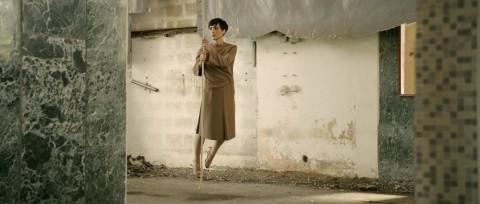Austrian-born Markus Schinwald is a video artist, choreographer, sculptor, painter, photographer, and fashion designer who divides his time between Vienna and Los Angeles. His diverse interests and knowledge of media result in elusive, eccentric scenes in which mental states effect bodily behavior. The history of psychoanalysis in Austria is a lingering influence in his work, as are drama and performance—a result of Schinwald’s work in the theater. Those cultural and personal backgrounds continue to impact his work in unexpected ways. According to Schinwald: “I have a very destructive relationship to theatre—I am obsessed by the idea of hurting it.”
His short film _1st Part Conditional_ (2004), which takes place in a nineteenth-century apartment, evokes such a desire. Within the span of three minutes, a bearded man seated in an armchair tensely observes a woman who appears to be having a seizure. Her body convulses in a fantastic manner, but the source of her pain is unclear. Perhaps her hysteria is a manifestation of some internal struggle, or maybe it is a reaction to external forces—the same ones that also cause the objects and furniture around her to break and fall apart.
In much of Schinwald’s art, instability serves as a way in which to view the body, not only as an individual being, but also as a physical object. For example, in his series of over-painted historical portraits, various odd apparatuses and prostheses obscure the sitters’ faces, thereby suggesting extreme impairment. In another series, he disassembled the legs of tables and chairs to construct mismatched anthropomorphic sculptures. He also has created motorized marionettes that perform peculiar actions like repeatedly lifting one leg or rocking back and forth while standing in a swing. Even more strange is Schinwald's photographic series _Contortionists_ (2003), in which women lounge, read, and talk on the telephone in discomfiting poses.
Schinwald explained the series was “based on the idea that the mind can do something like that to the body.” Similarly, his two-part film installation _Orient_ (2011) illustrates other ways in which the mind might affect the body. Accompanied by incoherent yet evocative voice-overs, a group of male and female characters engage in surreal performances in a picturesque abandoned building. While their choreographed movements include such familiar acts as leg scratching and brow wiping, the figures also float up ropes, climb on top of doors, and disentangle themselves from a pile of wires by tap dancing.
The scenarios swing from haunting to comedic—a man who attempts to keep up his ill-fitting trousers as they sink nearly to his knees or another who uses acrobatic movements as he attempts to release his leg, which has become trapped between two walls. Thus, rather than the eastern hemisphere, Schinwald’s Orient recalls the positioning of oneself in relation to unfamiliar locations and situations. Moreover, his stunning presentation acknowledges the significance of these oft-unacknowledged points in time and space. _—Kanitra Fletcher_

